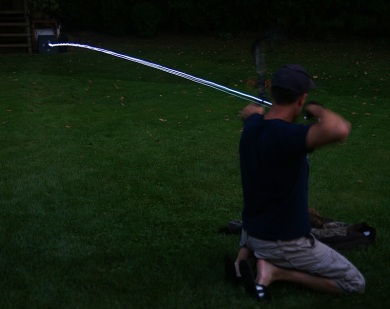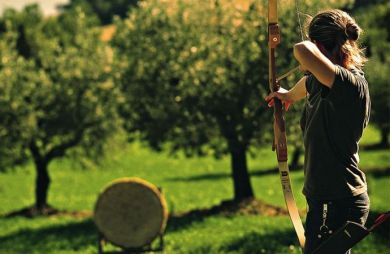The Secret to Instinctive Archery is your Shot Cycle (a Shot Cycle is everything you do to shoot an arrow), plain and simple. I have the books, the DVD’s, I have been to seminars and all I ever heard or read was for you to “Focus on the Target”. Let me tell you I have been doing that and guess what, I was not getting any better. I was getting frustrated, I had plateaued and I had no clue as to what to do next.
Being an Instructor myself (I train people in Muay Thai and I teach kids Martial Arts) for the past twenty years I know a thing or two about teaching / learning. So I thought about it and found the one group that trains the most archers, the Olympics. To train a large number of people you need to have …… a system. One that is repeatable, adaptable, teachable.
What I found is that they have broken the Shot Cycle into different phases or parts. This simple revelation has helped me get past that plateau and has helped me to teach archery in a more efficient manner (yes, I teach archery for a leadership group by of West Point). I took what they did and adapted it to what I do and it is a great tool to help you clean up your shooting.
The beauty of this was proven yet again yesterday for me. I was at the range and I was shooting like crap. The worst I have done in a long time. Instead of getting frustrated, I went over my shot cycle, step by step, I got better as I went and I fixed a nagging problem I have had. Ever since I switched to the under the chin anchor, from time to time, my arrows will fishtail, not all the time just some. I couldn’t figure it out and neither could those I asked, wrote to or even those I had watch me shoot. No, it was re-focusing on my shot cycle. I realized what was causing it was my Anchor. For some reason I would let the bottom of my hand turn out, which in turn twisted the string slightly and when I released the arrow, this twist would undo and cause the fishtailing.
Want to get better, then write down and practice your shot cycle, know it inside and out, so when things go wrong you won’t be in the dark as to why.
Here is the Shot Cycle: (Now I could go for days on each, but I won’t)
STANCE: How you stand can and will affect your shot. There are many ways to stand and yes, over time you will be able to shoot from almost any position. The point is that when you are learning or trying to get better you need to use the same stance every time. Remember the more variations in your shot cycle will show up in your accuracy.
NOCKING THEW ARROW: How you not doesn’t really affect accuracy and can be done how you like.
GRIP THE BOW: An often over looked area. How you grip you bow really does affect you shot. Squeeze too much on your pinky and you’ll shoot low, too much on the index and you’ll go high. The grip should be firm but relaxed. The bow should not be able to move around in your hand. You can take you fingers out of it altogether. The key is to grip the bow the same way each time.
GRIPPING THE STRING: Again, there are many ways to grip the string; Split Finger, Three Under, Pinch, Thumb Ring, etc. The key is to ensure that you grip it the same way every time.
SET POSITION: This is the stage where you’re ready to draw, at this point in time you start to “Focus” on the target, this one is more mental than physical.
DRAWING: Many ways to draw, Low, Middle or High. But do you do it the same way each time?
ANCHORING: Again many ways, but is you’re the same each time?
HOLDING: If you’re not a snap shooter, you do this, it might only be for a second or two. When in this stage you should feel the pressure through your arm and into your shoulder. I you feel the pressure on your arm and chest, you have not “locked it in” and your accuracy will suffer. This is what many people mean when they say “Use you Back muscles”
RELEASE / FOLLOW THROUGH: There is a nice debate on this, when you release does your hand stay put or move back to your shoulder? I find myself doing one way for a while and then the other and my accuracy shows it.
FEEDBACK: After you have shot think about the cycle and how it felt. If it was good then try to duplicate it. If the shot was bad, think about how it felt and see what was different.













